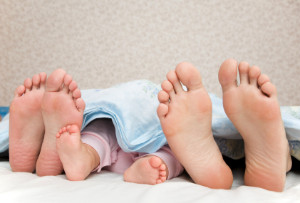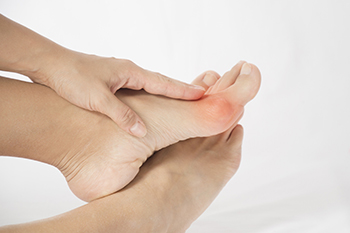Langley (604)-530-1561
Fax (778)-278-1561
Email podiatry@urton.ca
February 2023
Heel Pad Syndrome

There are several reasons why heel pain can develop, and one cause is heel pad syndrome. While heel pads break down due to normal use and aging, excessive wear and tear or injury can cause the heel pads to shrink in size. This condition can also result from obesity, other health or foot conditions, or from wearing poorly cushioned shoes. Heel pads are like shock absorbing cushions in the heels. They are composed of fat and flexible, but tough fibers. They not only absorb shock from the impact of standing and mobility, they help to distribute the body weight and protect the bones and joints in the foot. With this syndrome, the heel pads lose their elasticity and shock-absorbing capacity, and severe pain in the middle of the heel can develop. It can feel similar to a bad bruise without being visible. The good news is that this is a treatable condition which may improve with exercise. Since it is difficult to distinguish one cause of heel pain from another, it is suggested that you visit a podiatrist for a proper diagnosis and treatment for your particular heel pain.
Many people suffer from bouts of heel pain. For more information, contact William Urton, DPM of British Columbia. Our doctor can provide the care you need to keep you pain-free and on your feet.
Causes of Heel Pain
Heel pain is often associated with plantar fasciitis. The plantar fascia is a band of tissues that extends along the bottom of the foot. A rip or tear in this ligament can cause inflammation of the tissue.
Achilles tendonitis is another cause of heel pain. Inflammation of the Achilles tendon will cause pain from fractures and muscle tearing. Lack of flexibility is also another symptom.
Heel spurs are another cause of pain. When the tissues of the plantar fascia undergo a great deal of stress, it can lead to ligament separation from the heel bone, causing heel spurs.
Why Might Heel Pain Occur?
- Wearing ill-fitting shoes
- Wearing non-supportive shoes
- Weight change
- Excessive running
Treatments
Heel pain should be treated as soon as possible for immediate results. Keeping your feet in a stress-free environment will help. If you suffer from Achilles tendonitis or plantar fasciitis, applying ice will reduce the swelling. Stretching before an exercise like running will help the muscles. Using all these tips will help make heel pain a condition of the past.
If you have any questions please contact our office located in Langley, BC . We offer the newest diagnostic and treatment technologies for all your foot and ankle needs.
How Kawasaki Disease Impacts the Feet

If you are caring for a young child, then it is imperative that proper care and attention are given to the health of their feet. One disease that can negatively impact the health of a child’s feet is known as Kawasaki disease. This condition is primarily associated with throat problems and high temperatures in children. However, this disease can also bring about negative symptoms in the feet. Specifically, children who develop Kawasaki disease may notice abnormal symptoms in their feet. These children might have feet that are particularly painful or red, and they might also be somewhat swollen. During the second phase of Kawasaki disease, a child might also demonstrate skin that peels off on the feet. Peeling might also appear on the soles of the feet. Contact a podiatrist today for more information about Kawasaki disease and the feet.
Making sure that your children maintain good foot health is very important as they grow. If you have any questions, contact William Urton, DPM of British Columbia. Our doctor can provide the care you need to keep you pain-free and on your feet.
Keeping Children's Feet Healthy
Having healthy feet during childhood can help prevent medical problems later in life, namely in the back and legs. As children grow, their feet require different types of care. Here are some things to consider...
Although babies do not walk yet, it is still very important to take care of their feet.
Avoid putting tight shoes or socks on his or her feet.
Allow the baby to stretch and kick his or her feet to feel comfortable.
As a toddler, kids are now on the move and begin to develop differently. At this age, toddlers are getting a feel for walking, so don’t be alarmed if your toddler is unsteady or ‘walks funny’.
As your child gets older, it is important to teach them how to take care of their feet.
Show them proper hygiene to prevent infections such as fungus.
Be watchful for any pain or injury.
Have all injuries checked by a doctor as soon as possible.
Comfortable, protective shoes should always be worn, especially at play.
If you have any questions please feel free to contact our office located in Langley, BC . We offer the newest diagnostic and treatment technologies for all your foot and ankle needs.
The Etiology of Heel Spurs

A heel spur is essentially a hook-shaped bony formation that can sometimes develop on the underside of an individual’s heel bone. The spur will grow and point toward the toes of the foot. Interestingly, there has been some debate within the scientific community about the exact etiology, or cause, of heel spurs. For example, one’s hereditary propensity towards heel spurs was thought to be a contributing factor to the development of heel spurs. Today, it is primarily thought that excessive pronation is the main culprit for heel spurs. Overpronation is associated with unnatural biomechanics of the feet. This is all to say that excessive pressure or an awkward way of moving the feet when engaging in physical activity can contribute significantly to the development of heel spurs. Consider contacting a podiatrist today for more information about heel spurs and for any treatment that you might need.
Heel spurs can be incredibly painful and sometimes may make you unable to participate in physical activities. To get medical care for your heel spurs, contact William Urton, DPM from British Columbia. Our doctor will do everything possible to treat your condition.
Heels Spurs
Heel spurs are formed by calcium deposits on the back of the foot where the heel is. This can also be caused by small fragments of bone breaking off one section of the foot, attaching onto the back of the foot. Heel spurs can also be bone growth on the back of the foot and may grow in the direction of the arch of the foot.
Older individuals usually suffer from heel spurs and pain sometimes intensifies with age. One of the main condition's spurs are related to is plantar fasciitis.
Pain
The pain associated with spurs is often because of weight placed on the feet. When someone is walking, their entire weight is concentrated on the feet. Bone spurs then have the tendency to affect other bones and tissues around the foot. As the pain continues, the feet will become tender and sensitive over time.
Treatments
There are many ways to treat heel spurs. If one is suffering from heel spurs in conjunction with pain, there are several methods for healing. Medication, surgery, and herbal care are some options.
If you have any questions feel free to contact our office located in Langley, BC . We offer the latest in diagnostic and treatment technology to meet your needs.
Skiing With Bunions

Bunions are a particular foot affliction that can alter the shape of the feet. Specifically, this condition makes it so a bony bump or protrusion develops on the side of the big toe (or, less commonly, the pinky toe). Sometimes, individuals living with bunions have a more difficult time engaging in physical activity due to the condition. Some patients are interested to know whether or not they can still ski even if they develop bunions. If the bunions are a source of pain, then squeezing them into a tight pair of ski boots might not always be an advisable option. This is compounded by the fact that skiing, especially downhill, can exert pressure on the toes. If you are someone that likes skiing and are currently struggling with bunions, contact a podiatrist to schedule an appointment today.
If you are suffering from bunions, contact William Urton, DPM of British Columbia. Our doctor can provide the care you need to keep you pain-free and on your feet.
What Is a Bunion?
A bunion is formed of swollen tissue or an enlargement of boney growth, usually located at the base joint of the toe that connects to the foot. The swelling occurs due to the bones in the big toe shifting inward, which impacts the other toes of the foot. This causes the area around the base of the big toe to become inflamed and painful.
Why Do Bunions Form?
Genetics – Susceptibility to bunions are often hereditary
Stress on the feet – Poorly fitted and uncomfortable footwear that places stress on feet, such as heels, can worsen existing bunions
How Are Bunions Diagnosed?
Doctors often perform two tests – blood tests and x-rays – when trying to diagnose bunions, especially in the early stages of development. Blood tests help determine if the foot pain is being caused by something else, such as arthritis, while x-rays provide a clear picture of your bone structure to your doctor.
How Are Bunions Treated?
- Refrain from wearing heels or similar shoes that cause discomfort
- Select wider shoes that can provide more comfort and reduce pain
- Anti-inflammatory and pain management drugs
- Orthotics or foot inserts
- Surgery
If you have any questions, please feel free to contact our office located in Langley, BC . We offer the newest diagnostic and treatment technologies for all your foot care needs.








